Day 3: Sunday, June 13th
Our first night at the Lakeside Motel in Harrison, Michigan was uneventful. I had hoped to leave the room opened up for the night but the traffic noise was a bit much and so we closed up and turned on the AC and then later downgraded to just the fan.
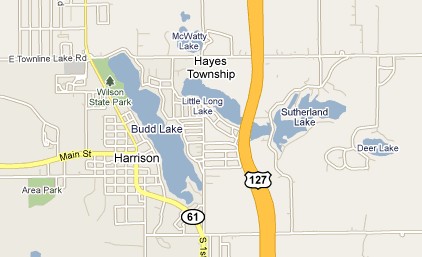
As you can see here, Budd Lake is no wilderness lake. It is sandwiched between busy roads and is ringed by both vacation homes and permanent residences as well as rentals and motels. But, any lake where you can wake up to the call of Loons, as we did on Saturday morning, is OK by me.

Common Loon
©
torontohiking.com
Click on the photos below for a larger image.

Betsy decided to go for an early morning paddle while the lake was still quiet and I retreated to the room to work on my journal.

Back from her paddle, Betsy catches up on her journal as well.
With journals updated and maps organized we planned the rest of the day. Our original plan was to drive down to Clare, about a half hour away and bike 15 miles out and back on the Pere Marquette Rail-Trail. But, we had awoke to mist and drizzle and the weather still looked threatening. So, we decided to go hiking on the Green Pine Pathway about 20 miles to the west of Harrison.
We packed the leftover pizza along with bug juice and rain gear and set off down the road at 11:00.
We found our way as far as Lake George and then lost our road and our bearings. Betsy went into a local grocery for directions and came back out with the news we were going to follow someone there who was heading that direction anyway. So, we trundled down the road and eventually go to the trail-head at SR 151. The entrance was partially blocked by a sheriff's vehicle. I saw no radar gun, but they must have been on some mission.
We followed our leader into the parking area and he wanted to know if we were hiking to the other end to camp out. We assured him we were not and were only there for a day hike. I gave him one of my ERT cards and he was on his way.
Betsy and I sat in the car and finished off the leftover pizza then donned out day packs and set off down the trail.

The trail entrance was flanked on both sides by Columbine (Aquilegia canadensis).

The first mile or so led us through an area which had be recently logged. We saw Sugar Maple stumps, some over 2 feet across at the base. Here Betsy is walking through a corridor of Big Tooth Aspen (Populus grantidentata).
Most commonly found on floodplains, gently rolling terrain, and the lower slopes of uplands. Soil must be moist but well aerated for good growth. Very shade intolerant; most shaded stems die. Pioneer species on disturbed sites, persisting in successional communities until senescence. Rapid height growth of suckers allows it to outcompete other sprouting species such as Red Oak (Quercus rubra) and Red Maple (Acer rubrum) on many sites. In the absence of disturbance, it is soon replaced by conifers and hardwoods.In the Great Lakes Region at the turn of the century, many mature pine forests were logged and burned.
Bigtooth Aspen and Quaking Aspen frequently dominated the postdisturbance forests. Without fire or other disturbance, these forests are being replaced by later successional, shade-tolerant species. Usually grows in even-aged mixed stands, most commonly with Quaking Aspen. Codominant in both hardwood and conifer forests; does not occur as a subdominant because of its extreme shade intolerance. Quaking Aspen (Populus tremuloides) is the predominant species in aspen stands in the Great Lakes Region, but Bigtooth Aspen dominates on the drier upland sites. Aspen stands dominated by Bigtooth Aspen are generally more open than those dominated by Quaking Aspen. More disease resistant than Quaking Aspen.
Source: WikiPedia

Scat or owl pellets?? Can you tell me?

This is Orange Hawkweed (Hieracium aurantiacum). It is commonly found in disturbed, sunny areas in the north.
It is a beautiful flower, but itis non-native and invasive throughout the Great Lakes region and elsewhere.
Orange hawkweed invades northern moist pastures, forest openings, abandoned fields, clearcuts and roadsides. Its greatest density occurs on newly disturbed sites, as it is an early succession plant. Its largest distribution is in northeastern Minnesota.
Loss of native plant diversity in infested areas, orange hawkweed colonizes rapidly forming a solid mat of rosettes. The plant may have allelopathic effects on neighboring plants.
Orange hawkweed is a native of Europe and is listed on the MDA Secondary noxious weeds list in Minnesota.

This is Sweet Fern, which, despite it's common name is not a fern. Actually, it is a deciduous shrub in the monotypic genus Comptonia (containing only Comptonia peregrina).
When the leaves are crushed they give off a pungent, sweet scent.

The leaves of Big Tooth Aspen.
On our hike we began to see many familiar northern tree species such as White Birch, Balsam Fir, Swamp Cedar (actually and arborvitae - Thuja, not a cedar - Juniperus) and Canadian Yew.

The trail was well marked with blue blazes and these plastic markers.
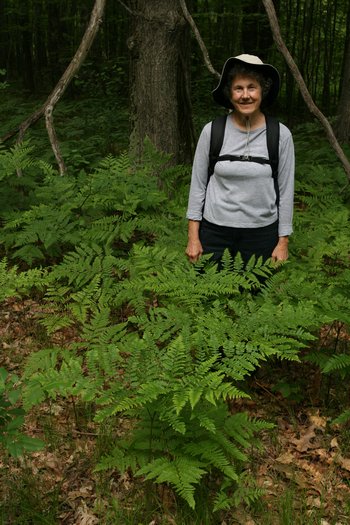
Betsy and the Bracken fern.
This fern is found just about everywhere. It occurrs in temperate and subtropical regions throughout much of the world, including most of Europe, Asia, and North America.

A very typical scene - Bracken fern is the dominant herbaceous undergrowth in the open woods.

Alternate-leaved dogwood (Cornus alternifolia)? Pretty sure.

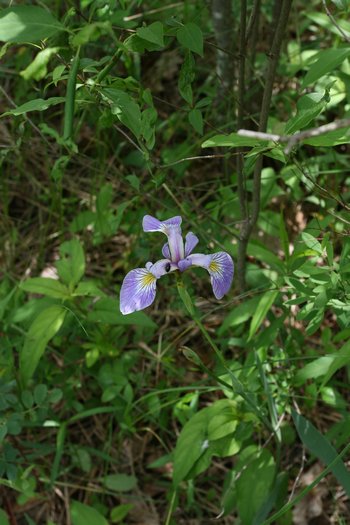
This is Harlequin Blue Flag Iris (Iris versicolor). We saw it in several places along the swamp margins.

The Aspens really closed in on the trail in several places. Soon, the trail will be gone!

We saw all the common ferns one would expect. Shown here is Sensitive Fern (Onoclea sensibilis).
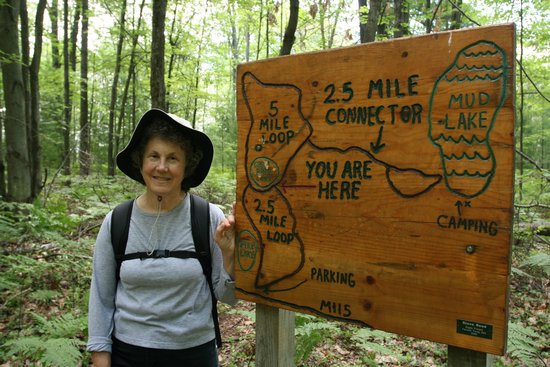
After about a mile we reached out trail intersection which would take us on the planned 5 mile loop.
Just about 100 feet beyond this is sign we noticed a sheet protector hanging from a tree. I unfolded it and it stated: "Trail closed ahead due to beaver". It was not dated and gave no indication of how far ahead the trail was closed. So, we decided to find out.
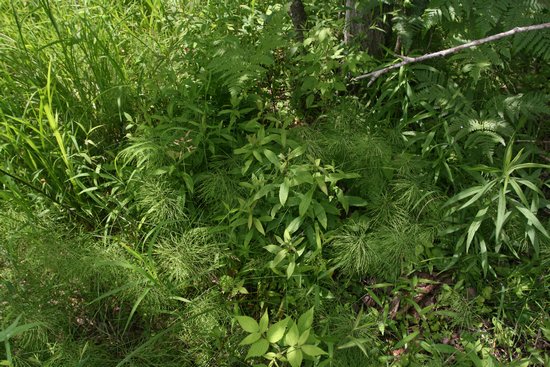
This is Woodland horsetail (Equisetum sylvaticum).

I was really excited to see this plant which I first saw on a "Fern Survey" of Michigan back in 1978. It was a trip I took with Herb Wagner. Herb was not a only a preeminent pteridologist but a good naturalist as well.
We later saw a colony of the Woodland horsetail so dense it looked like green mist when viewed from above. We also saw another northern horsetail, Equisetum pratense, the Meadow Horsetail.
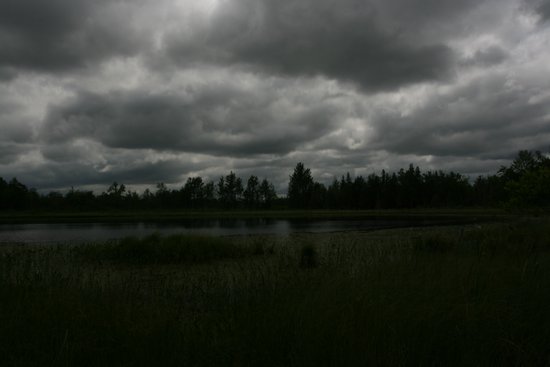
A dark and moody look at Green Pine lake.
It was at this point we found out first hand about the trail closure. The blues blazes took us through wetter and wetter terrain until they disappeared out into the water. I tried to find a way around this but I could not and we reluctantly headed back the way we came. Not wanting to turn back completely we decided to take the short loop at the previous intersection.
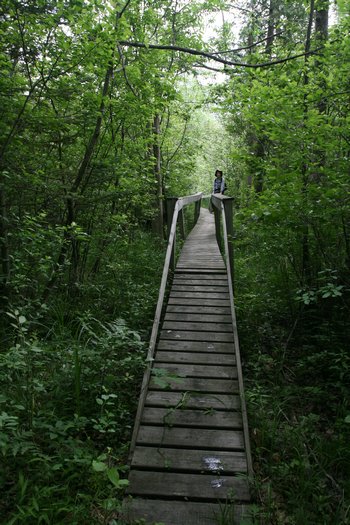
One of several board walks on the short loop.
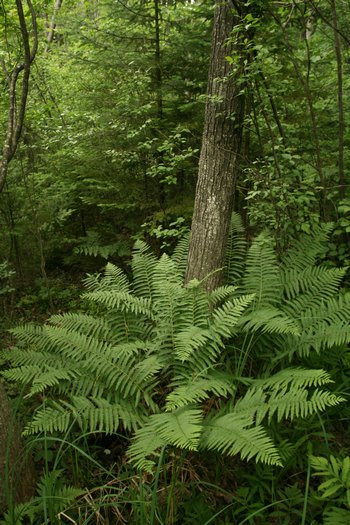
A lovely clump of Cinnamon fern.

Not far from the trail-heading parking are we saw thse sprouts on one of the many Sugar maple stumps on the first and last legs of the hike..
Since our hike ended prematurely we decided to drive to the opposite end of the Natural Area and see tale a look at Mud Lake.

A typical Michigan sand road. I snapped this shot by holding the camera out of the window while driving.
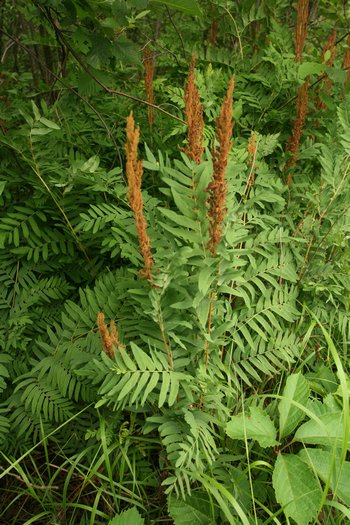
At the far end was an isolated DNR campground directly adjacent to the lake. Only one of the 15 sites was occupied.
We took a look at the lake and Betsy came close to going in for a skinny dip. But, she had left her water shoes behind and so decided to wait and take a dip back at Budd lake.
Along the lake shore we saw this nice clump of Royal Fern. We also saw Interrupted fern which completed the trio of Osmundas native to the eastern US.
After looking around the campground we decided to walk the 1 mile loop which went through both low swampy areas and drier, higher woods. On this hike the mosquitoes were pretty pesky as the wind had died down an it was more humid.
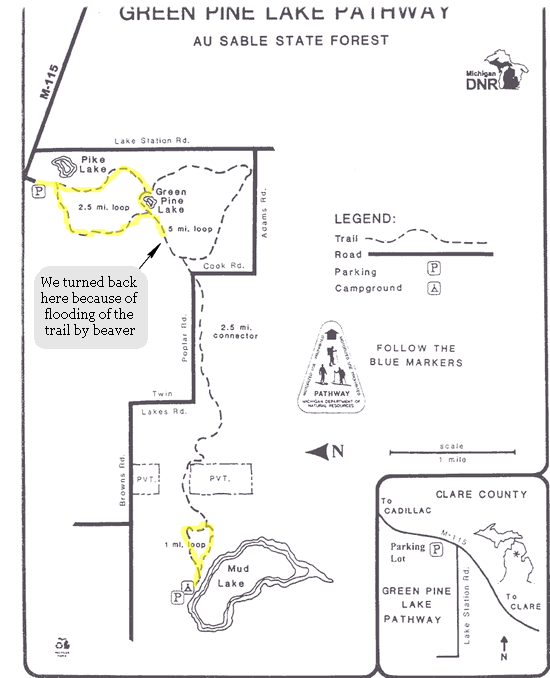
We then drove the 25 miles back to the hotel. Upon our return we scouted places for dinner and decided on a local bar down he road from the hotel. Then, Betsy took her swim and I caught up on my email and backed up my files to a portable drive.
After cleaning up we headed down to the Stix Bar & Grill. To our surprise there was no smoking. Over a coupla beers we checked out the menu which was a bit more than just bar food. Betsy decided on the fried fish dinner and I ordered the French Dip.
As we sat there more folks drifted in. They were obviously locals and all knew each other. I watched the bar maid make and deliver a 3 shot rum and coke to a plump 20 something. I wonder how many of those she had?
Our meal came and it was one of those times I regretted not having my digi-snap. Have you ever seen French Dip served on hot dog buns? Me neither!
The meals were tolerable. Anyway - we were there for the ambiance, not the cuisine...
We people watched as we finished our beers. There was a guy next to us who was on the rowdy side and at one point he asked how much my meal was. When I replied when he screamed "That's a great price!!" He was mimicking the idiotic Staples from TV.
The woman who he was with apologized for him and said they only let him out on Sundays. I told her this was our lucky day.
Then, back to the hotel for another early evening and restless night.